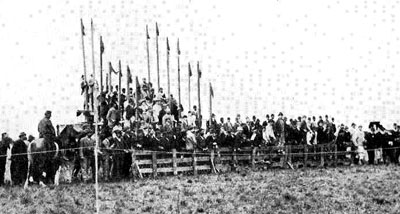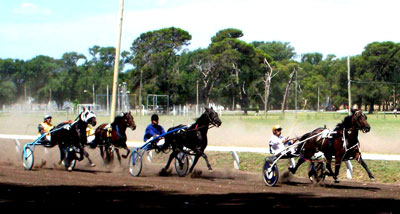|

The Grand Stand at Venado Tuerto's
race course
(John Macnie, 1925) |
In 1864, sheep-farm owner John Murphy of Salto wrote to his
brother in Wexford. ‘All the men are now taking care of
the flocks on foot, though having sixteen horses. Yet
there are only some one or two that would be safe to
saddle as they can with difficulty support their own
weight. I am getting ten or more young asses tamed in, and
I shall then have a good supply so long as they are left
with me’ (Murphy to Murphy, July 1864). In that year, when
two more Irish labourers arrived from Ireland
to work at Murphy’s establishment, he sent them from Buenos Aires
to his ranch on the railway to Luján and then on the post
coach to Salto because they could not find docile horses
for them. Just two years later, one of these workers came
second in the races in Salto.
In 1865 Murphy commented on the news in The Standard
newspaper of Buenos Aires, which was customarily included
in his letters to Ireland.
‘You see by this paper that we have horse racing here, as
well as at home’ (Murphy to Murphy, 25 March 1865). And
later that year, he added that he was
expecting
some time ago to take a horse in to run in the English
races, which you see advertised in the Standard for the
1st November, but owing to the shearing coming on I
declined doing so. But I will have better time against the
Autumn meeting, which generally takes place in March each
year. I don’t recollect if I sent you a paper with some
letters in it about our races last March, by which you may
have seen that my horse beat at his ease some very
crack-horses that was brought from far off to beat all
before them
(Murphy to Murphy, 25 September 1865).
For
Murphy, it was important to let everybody know at home and
among his friends and neighbours in Wexford that he owned
racing horses. He mentioned this in several letters, and
some years later he proudly announced the organisation of
races on his own land, where ‘we are to hold some Races at
the Estancia on next Monday. I take out the prizes with
me, two saddles, bridle, whip & spurs. They are to be
private Races for horses of the neighbourhood, for our own
amusement, & to be followed by a dance that night’ (31
August 1873). Owning racing horses and organising private
races were marks of social prestige among the Irish in Ireland
and in Argentina.
Among the Irish residing in the rural areas of Buenos
Aires, the races were the most important social event of
the year. The horse-racing meeting of 1867 in Capilla del
Señor ‘may be taken as the starting point in what was for
a number of years the most important and successful Irish
race-meeting in the country. The names of some of the race
horses and their owners are worth preserving. First in the
principal race, Matthew Dillon’s Chieftain; Second,
John Shanaghan’s Fenian Boy; Third, Patrick
Murray’s Shamrock; Fourth, George Bird’s
Clear-the-Way, and last, Martin Fox’s Volunteer’
(Murray 1919: 224).
Vigilant Roman Catholic priests were present at the racing
meetings to alert the people about the dangers associated
with gambling, drinking and dancing, and to collect funds
to support the building of rural chapels, schools,
libraries and other works. In 1872, Fr. Patrick Dillon and
Fr. Samuel O’Reilly opened St. Brigid’s chapel in La Choza,
on John Brown’s land (district of Luján) (The Southern
Cross, 1975: 33). ‘The day of its inauguration
was one of great feasting in the district, with
horse-racing, dances, etc., when the religious ceremony
was over. Canon Dillon of Buenos Aires, who was a noted
preacher, delivered the inaugural sermon which was said to
be a very brilliant one. Mr. Browne was not alone forward
in advancing religious and charitable institutions, he
also took a leading part in promoting social pleasures and
pastimes, and some of the first annual race-meetings in
the camp were held on his estancia’ (Murray 1919: 219).
The priests also sought the association and
collaboration of the Irish in Argentina, who came from
different counties and social origins. The traditional
feuds between the immigrants from southeast Ireland and
those of the Irish Midlands owed less to geographical
reasons than to social standing. Many Wexford people had a
manifest contempt towards the Westmeath, Offaly, Longford
and other Irish immigrants, and perceived themselves as
better educated and of a higher cultural and moral
standing.
This aspect of social life was manifest in
social meetings in which both groups came together, as in
our English races [that] passed off on the
25th last month. There were about two thousand foreigners
and all the respectable natives of the surrounding
partidos. Partido, or parish, is a district of country
extending ten or twelve leagues in diameter each way, say
a space of 100 square leagues. We whipped all before us. I
won the Cup and brother William won the Plate with one of
my horses. Wexford won all that was seen for our namesake
Murphy. Tom won the saddle, which so much enraged the
Ballinacarryas [5]
(Westmeath people), that they collected in a ruffianly mob
and so much disturbed the peace that the races had to be
broken up. I could have won some hundreds of pounds had I
been a gambler, mine being a young horse untrained and his
antagonist a celebrated racer. Peter Cormack rode. The mob
headed by the owner of beaten horses (I mean the horse
that pushed mine as there were only one out of the six
that run done any thing) got so ruffianly excited that
they insulted the people of all nationality. Even the
Clergy did not escape their blogardeism and I am glad to
say that there were not a single individual of any other
county mixed in. Our clergyman of both parishes has on
these last two Sundays told them what they are, and the
disgrace they have been to all Irishmen in this country
(Murphy to Murphy, 20 October 1867). |


